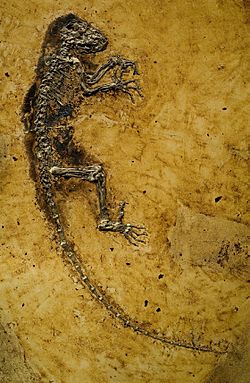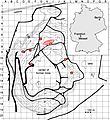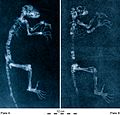Darwinius facts for kids
Quick facts for kids Darwinius masillaeTemporal range: Eocene 47 mya
|
|
|---|---|
 |
|
| Scientific classification | |
| Kingdom: | |
| Phylum: | |
| Class: | |
| Order: | |
| Suborder: | |
| Infraorder: | |
| Family: |
Notharctidae
|
| Subfamily: |
Cercamoniinae
|
| Genus: |
Darwinius
|
| Binomial name | |
| Darwinius masillae Franzen et al., 2009
|
|
Darwinius is a genus of primates known from only one fossil. It was discovered in 1983 by an amateur at the Messel Pit. This is a disused shale quarry noted for its astonishing fossil preservation, near the village of Messel, about 35 km (22 miles) southeast of Frankfurt am Main in Germany.
The fosssil dates from the Eocene epoch, 47 million years ago. The genus Darwinius was named to celebrate Charles Darwin on his bicentenary and the species name masillae honors Messel, where the specimen was found. The creature appeared superficially similar to a modern lemur. It is the only known specimen of its species.
The fossil, nicknamed 'Ida', was divided into a slab and partial counterslab after the excavation. The two parts were sold separately, was not reassembled until 2007.
Description
The specimen was privately collected and sold in two parts. Only the lesser part was known earlier. The second part shows that the skeleton is the complete primate fossil known. It includes the skeleton, soft body outline and contents of the digestive tract.
Skull radiography shows teeth developing within the juvenile face. The individual was a weaned and independent-feeding female that died in her first year of life. She was "an agile, nail-bearing, generalized arboreal quadruped living above the floor of the Messel rain forest".
Images for kids
-
Radiographs of the Darwinius holotype fossil, revealing the fabricated parts of the counter-slab






